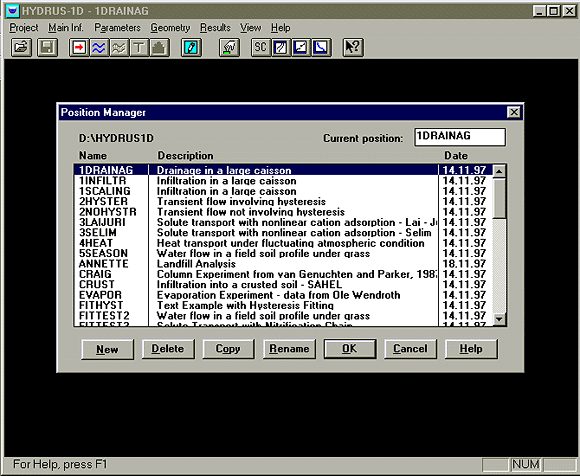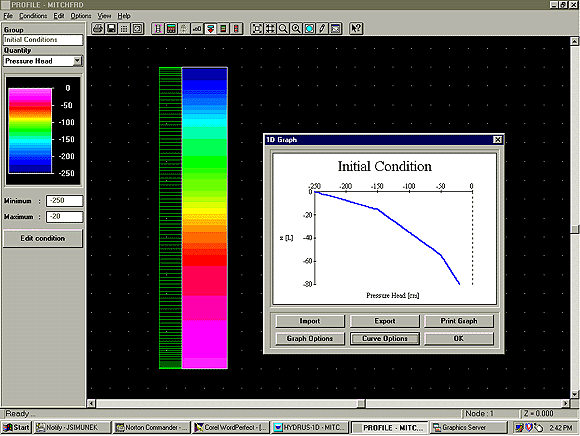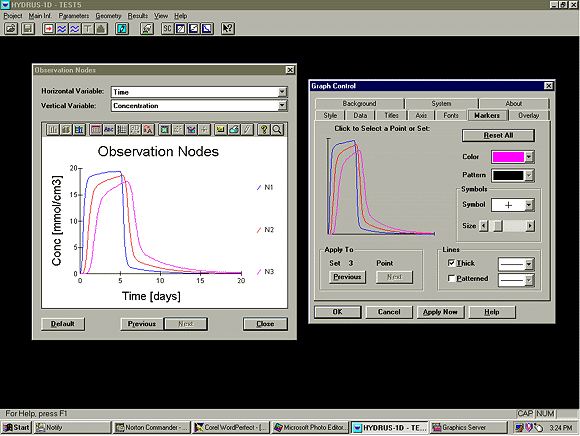| HYDRUS-1D Model |

|
| The latest version of this program and its manual can be downloaded from the software download area |
| April 2005 Version: 3.01 |
|
HYDRUS-1D is a Microsoft Windows-based modeling environment for analysis of water flow and solute transport in variably saturated porous media. The software package includes the one-dimensional finite element model HYDRUS (version 7.0) for simulating the movement of water, heat, and multiple solutes in variably saturated media. The model is supported by an interactive graphics-based interface for data-preprocessing, discretization of the soil profile, and graphic presentation of the results. |
|
|
|
HYDRUS Model (version 7.0) The HYDRUS program is a finite element model for simulating theone-dimensional movement of water, heat, and multiple solutes in variably saturated media. The program numerically solves the Richards' equation for saturated-unsaturated water flow and Fickian-based advection dispersion equations for heat and solute transport. TheFlow equation incorporates a sink term to account for water uptake by plant roots. TheHeat transport equation considers conduction as well as convection with flowing water. TheSolute transport equations consider advective-dispersive transport in the liquid phase, and diffusion in the gaseous phase. The transport equations also include provisions for:
and/orNonequilibrium reactions between the solid and liquid phases,
|
|
|
| The Unsaturated Soil Hydraulic Properties are described using van Genuchten [1980], Brooks and Correy [1964] and modified van Genuchten type analytical functions. Modifications were made to improve the description of hydraulic properties near saturation. The HYDRUS code incorporates hysteresis by using the empirical model introduced by Scott et al. [1983] and Kool and Parker [1987]. This model assumes that drying scanning curves are scaled from the main drying curve, and wetting scanning curves from the main wetting curve. HYDRUS also implements a scaling procedure to approximate hydraulic variability in a given soil profile by means of a set of linear scaling transformations which relate the individual soil hydraulic characteristics to those of a reference soil. Root growth is simulated by means of a logistic growth function. Water and salinity stress response functions can be defined according to functions proposed by Feddes et al. [1978] or van Genuchten [1987]. The governing flow and transport equations are solvednumerically using Galerkin type linear finite element schemes. Integration in time is achieved using an implicit (backwards) finite difference scheme for both saturated and unsaturated conditions. Additional measures are taken to improve solution efficiency for transient problems, including automatic time step adjustment and adherence to preset ranges of the Courant and Peclet numbers. The water content term is evaluated using the mass conservative method proposed by Celia et al. [1990]. Possible options for minimizing numerical oscillations in the transport solutions include upstream weighing, artificial dispersion, and/or performance indexing. HYDRUS implements a Marquardt-Levenberg type parameter estimation technique for inverse estimation of selected soil hydraulic and/or solute transport and reaction parameters from measured transient or steady-state flow and/or transport data. The procedure permits several unknown parameters to be estimated from observed water contents, pressure heads, concentrations, and/or instantaneous or cumulative boundary fluxes (e.g., infiltration or outflow data). Additional retention or hydraulic conductivity data, as well as a penalty function for constraining the optimized parameters to remain in some feasible region (Bayesian estimation), can be optionally included in the parameter estimation procedure. |
|
|
|
User Interface A Microsoft Windows-based graphical user interface (GUI) manages the input data required to run HYDRUS, as well as for nodal discretization and editing, parameter allocation, problem execution, and visualization of results. All spatially distributed parameters, such as soil type/layer, root water uptake distribution, and the initial conditions for water, heat and solute movement, are specified in a graphical environment. The location of discretization nodes can be graphically edited by a user to optimize the thickness of different elements. The program includes controls to allow a user to build an application specific flow and transport model, and to perform graphical analyses on the fly. Both input and output can be examined using graphical tools. The HYDRUS-1D shell program translates all geometric and parameter data into the HYDRUS input format. File management is handled by a sophisticated project manager. Post-Processing Post-processing is also carried out in the shell. HYDRUS-1D offers graphs of the distribution of the pressure head, water content, water and solute fluxes, root water uptake, temperature and the concentration in the soil profile at preselected times. Output also includes variable-versus-time plots, such as actual, potential and cumulative fluxes across boundaries or leaving the root zone. Observation points can be added anywhere in the profile to obtain graphical output for the water content, pressure head, temperature, and/or the concentration. Peripheral devices supported include most popular types of printers and plotters. A small catalog of soil hydraulic properties is included in the program. Extensive context-sensitive, online Help is part of the interface. Test Examples distributed with the model: Direct:
Inverse:
|
| System Requirements:
Intel 80386 with math coprocessor, Intel 80486DX, or higher processor, 4 Mb RAM, DOS 5.0 or higher, hard disk with at least 10 Mb free disk space, VGA graphics (SVGA with 256 colors recommended), MS Windows 95, 98, or Windows NT. |
| Authors:
J. Simunek, K. Huang, M. Sejna, and M.Th. van Genuchten |
|
Technical contact: |



